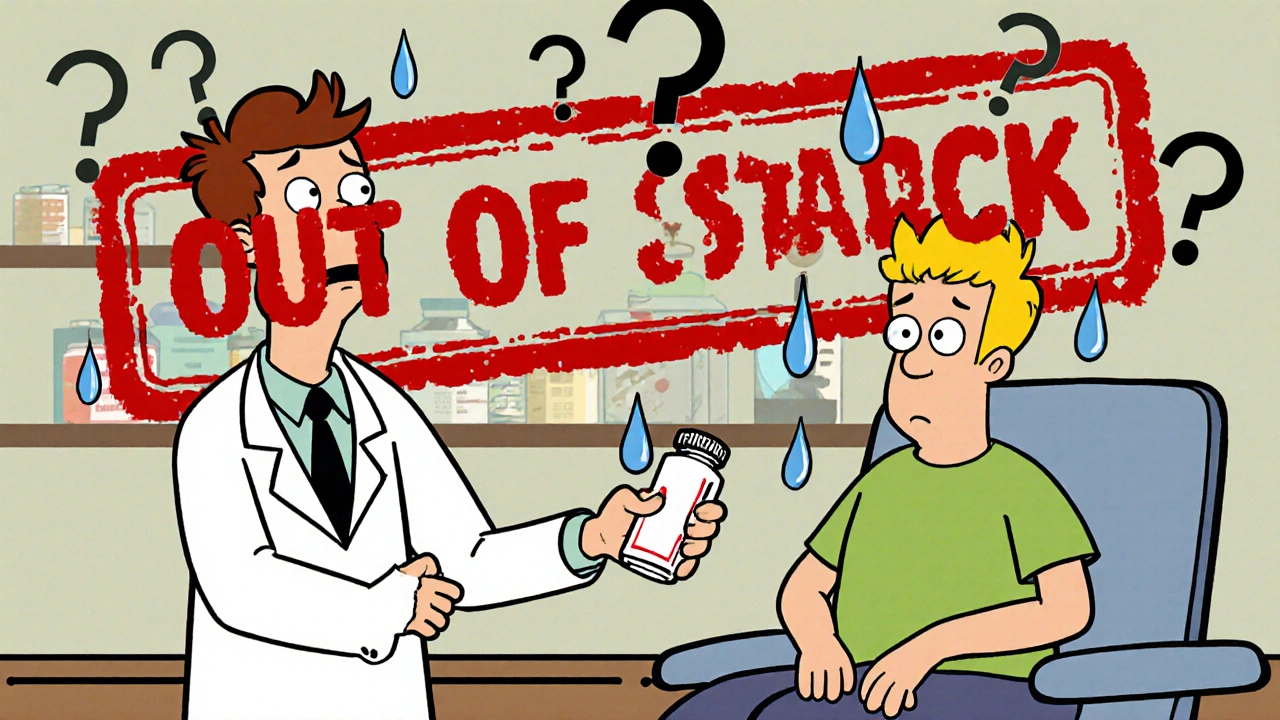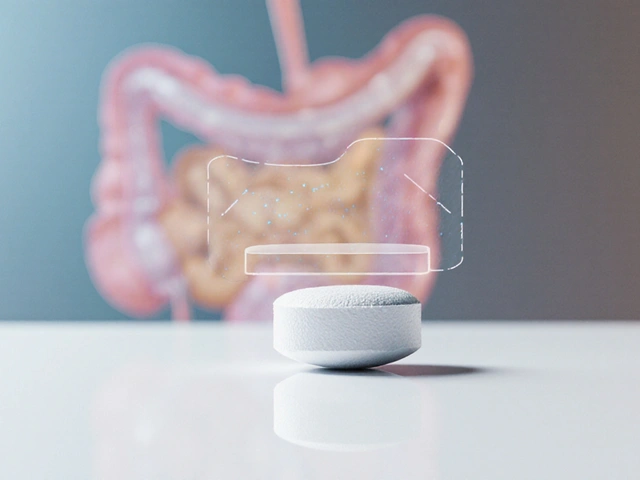When a patient needs a life-saving drug and it’s simply not there, the consequences aren’t theoretical-they’re immediate, personal, and sometimes fatal. In 2025, more than 250 medications remain in short supply across the U.S., leaving doctors to choose between delaying treatment, switching to less effective alternatives, or telling patients they can’t get their medicine at all. This isn’t a rare glitch. It’s the new normal in American healthcare.
What’s Really Happening When a Drug Runs Out?
A drug shortage isn’t just a stockout at your local pharmacy. It means the entire supply chain-from raw ingredients to finished pills-has broken down. The most common causes? Manufacturing failures, raw material shortages, and companies quitting low-profit generic drugs. In 2023, nearly half of all shortages traced back to global supply chain issues. Another third came from quality problems at factories. And 83% of the drugs in short supply are generics, which make up 90% of prescriptions but earn manufacturers pennies per dose.When a drug like heparin-an anticoagulant used in every cardiac surgery-disappears, hospitals don’t just panic. They scramble. Nurses and pharmacists spend 15 to 20 hours a week per shortage just tracking down alternatives, rewriting protocols, and training staff. Pediatric hospitals, which need special dosing forms, spend even more time. One hospital system reported spending 47 hours just to switch from one IV saline brand to another.
Who Gets Hurt the Most?
It’s not just the elderly or the uninsured. It’s children with leukemia waiting for asparaginase, a drug that can delay treatment by two weeks during a shortage. It’s cancer patients whose chemotherapy gets pushed back because nelarabine isn’t available. It’s diabetics who can’t get insulin because of packaging delays. It’s people in pain who can’t fill their opioid prescriptions because manufacturers stopped making them.According to the National Institutes of Health, 65% of pharmacy directors have had to cancel or delay procedures because of missing drugs. Nearly one in three reported direct harm to patients-like allergic reactions from substitute drugs, infections from delayed antibiotics, or strokes from missed blood thinners. In one case, a cardiac center had to redesign its entire anticoagulation protocol during a heparin shortage. Procedure times jumped 22%. Errors increased by 18%.
The Hidden Costs of Missing Medicine
The financial toll is staggering. Hospitals spent nearly $900 million in 2023 just on extra labor, emergency purchases, and staff training to cope with shortages. Patients paid more, too. Out-of-pocket costs rose by nearly 19% during shortage periods. Some people skipped doses. Others stopped taking meds altogether. One study found that 31% of patients with chronic conditions didn’t fill prescriptions because of availability or cost-adding up to an estimated 1.1 million potential deaths among Medicare patients over the next decade.And it’s not just drugs. When IV saline bags vanish, emergency rooms start rationing fluids. When antibiotics disappear, doctors turn to older, more toxic options. When anesthesia drugs run out, surgeries get postponed. Patients wait longer. Pain worsens. Recovery slows. In some cases, people die waiting.

Why Is This Getting Worse?
The system was built to prioritize low cost over resilience. Companies make more money selling brand-name drugs than generics. So when a generic drug’s price drops below $0.10 per pill, many manufacturers walk away. The FDA has only a few dozen inspectors for hundreds of overseas factories. And when one factory fails-a common occurrence in India and China-there’s no backup.The 2022 Drug Shortage Electronic Registration and Notification Act forced manufacturers to report potential shortages six months in advance. That helped. But many still delay reporting. And even when they do, there’s no legal requirement to fix the problem. The FDA can’t force a company to produce more. It can only ask.
What Are Hospitals Doing About It?
Most large hospitals now have dedicated shortage response teams. They use software that tracks inventory in real time and alerts them when a drug is running low. Some join group purchasing organizations like Vizient, which pools buying power to secure better supply deals. Others stockpile critical drugs-even if it means paying triple the price.But these are band-aids. One hospital pharmacist told me they’ve had to train staff on over 15 different alternative protocols in the last year alone. Each switch means more confusion, more errors, more stress. And it doesn’t stop the next shortage from coming.

What Can Patients Do?
You can’t fix the supply chain. But you can protect yourself. If you take a daily medication, ask your pharmacist: Is this drug currently in short supply? If yes, ask if there’s a therapeutic alternative. Don’t assume your prescription is safe just because it’s been the same for years.Keep a 30-day supply on hand if possible. Talk to your doctor about backup options before you run out. If your medication is delayed or changed without explanation, speak up. Your voice matters.
And if you’re on a high-cost drug like cancer therapy or insulin, connect with patient advocacy groups. Many have emergency drug access programs. Some even help with shipping from overseas when U.S. supplies fail.
The Bigger Picture
This isn’t just about pills and vials. It’s about trust. When patients rely on a system to deliver life-saving medicine-and it fails-faith in healthcare erodes. People stop going to the doctor. They skip screenings. They avoid treatment because they fear the medicine won’t be there.The U.S. government has held hearings. Congress has passed laws. Hospitals have spent millions on software. But the root problem remains: there’s no financial incentive to make cheap, essential drugs reliably. Until that changes, shortages will keep happening. And patients will keep paying the price.
For now, the only certainty is this: if your life depends on a drug, you can’t assume it’ll be there when you need it. You have to plan for it. And you have to demand better.






Stephanie Deschenes
November 24, 2025 AT 17:13It’s terrifying how normalized this has become. I work in oncology, and we’ve had to switch chemo protocols three times in six months. Each time, patients get anxious, side effects change, and we lose weeks of treatment time. No one talks about the emotional toll on the staff who have to explain, again, that the medicine they’ve relied on for years is just… gone.
Bea Rose
November 25, 2025 AT 12:08This is capitalism.
Bethany Buckley
November 26, 2025 AT 17:14One cannot help but observe the structural epistemological collapse of pharmaceutical commodification under late-stage neoliberalism. The reduction of life-sustaining pharmacopeia to marginal-profit commodities reveals a pathological inversion of bioethics - where the market, not the patient, dictates biological survival. The FDA’s toothless advisory role is not regulatory failure; it is ideological complicity.
Consider: a vial of heparin, produced at scale in a GMP-certified facility in Hyderabad, costs $0.12. Yet, the administrative overhead, regulatory fragmentation, and shareholder expectations render its production economically irrational. The system doesn’t break - it optimizes for entropy.
And yet, we’re told to ‘be proactive’ as patients? As if personal resilience can compensate for institutional abandonment. The rhetoric of ‘patient empowerment’ is a neoliberal smokescreen - a distraction from the fact that we’ve outsourced the moral responsibility of care to the profit motive.
It’s not a shortage. It’s a design feature.
Perhaps we should treat essential medicines as public goods - like clean water or fire departments. Not as products to be traded on quarterly earnings calls.
But then again, who has the political will to dismantle a $1.3 trillion industry built on the illusion of choice?
Vanessa Carpenter
November 28, 2025 AT 04:40I read this and just cried. My mom’s on insulin. She’s been fine for years - then last month, the pharmacy said they couldn’t get her brand. Took three weeks to get it back. She lost 12 pounds because she was scared to use the substitute. We’re lucky. Others aren’t.
Cynthia Boen
November 29, 2025 AT 06:16Stop pretending this is complicated. It’s corporate greed. Drug companies shut down generic production because they can make more money selling useless supplements on Amazon. The FDA is a joke. Congress is bought. You want change? Boycott Big Pharma. Stop paying for their luxury cars.
Amanda Meyer
November 30, 2025 AT 20:43I understand the frustration, but let’s not conflate market failure with moral failure. The reality is that generic drug manufacturing requires massive capital investment, and margins are razor-thin. When a factory in China fails inspection, there’s no immediate replacement - because no one else is willing to take the financial risk. We need policy reform, not outrage.
That said - the lack of mandatory production quotas for essential generics is indefensible. The FDA should have authority to compel production or license alternatives. This isn’t about ideology. It’s about public safety.
Jesús Vásquez pino
December 2, 2025 AT 08:32So what’s the solution? More regulations? More bureaucracy? We’ve got 2000 pages of FDA rules and still no heparin. The problem isn’t the law - it’s the lack of accountability. Who gets fired when a kid misses chemo because a factory in India got shut down? Nobody. That’s the real scandal.
hannah mitchell
December 4, 2025 AT 00:11I’ve been on the same blood pressure med for 12 years. Never thought twice. Now I keep a 90-day supply. Just in case. Feels weird, but I’m not taking chances anymore.
vikas kumar
December 4, 2025 AT 14:41In India, we know this pain. Many of these drugs are made here - but the workers are underpaid, factories are rushed, inspections are political. The West buys cheap, then blames us when it breaks. We’re not the villains. We’re the broken link in a chain no one wants to fix.
Shannon Amos
December 5, 2025 AT 18:03So basically, we’re all just playing Russian roulette with our prescriptions now? Cool. I’ll just keep my fingers crossed and hope the next pill I get doesn’t turn me into a zombie.
stephen riyo
December 6, 2025 AT 00:45Wait, so if a drug is in shortage, does that mean my doctor can just give me something else without telling me? Like… what if I’m allergic? I had a reaction last year to a substitute - they didn’t even tell me it wasn’t the same drug. This is insane.
Wendy Edwards
December 7, 2025 AT 17:24My cousin’s 8-year-old has leukemia. They had to wait 6 weeks for asparaginase. Six weeks. She lost her hair twice. Her mom cried every night. And now they’re telling her to ‘stay positive’? No. Tell the CEOs to stop being greedy. Tell Congress to do something. This isn’t ‘unfortunate’ - it’s criminal.
Jaspreet Kaur
December 8, 2025 AT 20:55When the system treats life as a commodity, death becomes an accounting entry. We have the technology to make these drugs. We have the knowledge to distribute them. But we lack the will. Why? Because we’ve forgotten that medicine is not a business - it’s a covenant between humanity and healing
Gina Banh
December 10, 2025 AT 14:12Insulin shortage? That’s a crime. It’s been around since 1921. We’ve had the science for over a century. Yet people die because a corporation decided $0.10/pill isn’t profitable enough. The fact that this is still happening in 2025 is a moral indictment of our entire system.
Deirdre Wilson
December 10, 2025 AT 20:02I used to think ‘drug shortage’ meant the pharmacy was out. Now I know it means someone’s life is on hold. Like, really on hold. Like, ‘will I live to see my kid’s graduation?’ hold. That’s not a glitch. That’s a betrayal.
Damon Stangherlin
December 12, 2025 AT 18:05Hey, I’m a nurse. We’ve had to use expired saline bags because we ran out. Not because we’re careless - because we had no choice. It’s not just the drugs. It’s the IV fluids, the antibiotics, the anesthetics. Everything’s shaky now. And we’re just supposed to keep smiling while we do it.
Ryan C
December 13, 2025 AT 04:53Actually, the real issue is the FDA’s outdated approval process. They still require full clinical trials for generic bioequivalence - even when the original drug has been used for 50 years. We need a fast-track for proven generics. Also, why aren’t we stockpiling critical drugs like we do for vaccines? 🤔